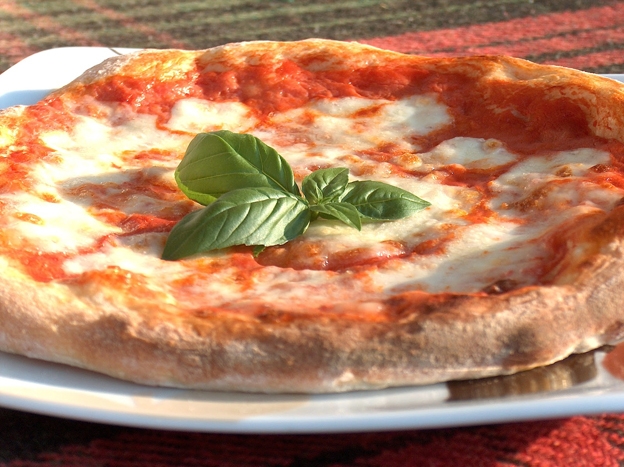
Margherita Pizza (Photo by Italy Magazine)
Olive Garden came to my hometown when I was about eight years old. I begged my parents for weeks to take me there. My family dressed up for a nice dinner out and happily waited twenty-five minutes for a table along with a dozen other Wisconsonite families overjoyed at a Friday night out at Olive Garden. I stuffed myself with salad and bread sticks and ordered the manicotti. Really, this was such a life moment I still remember what I ordered.
The restaurant smelled like too-sweet wine and tomato paste. Dean Martin’s That’s Amore was piped into every room of the restaurant including the bathroom (a bathroom with overdone gold accents and a faux-marble counter). And on the car ride home, my family decided that that was for sure the best Italian food we had ever had.
Fast-forward a decade and I’m sitting in a café in Florence, Italy, eating pasta so fresh with a tomato sauce so light you’d think they just smashed some tomatoes in olive oil and basil and tossed it with minute-boiled pasta (for all I know they did). Authentic Italian food. Needless to say, nothing like Olive Garden.
America has its own way of in-authentically recreating “authentic” world cuisine. Olive Garden is admittedly an overly commercial example and there are much (much much) better Italian-style restaurants to be found. Wherever you eat, though, it’s Italian-style, not Italian. Even in New York, even in Little Italy, it’s Italian-style.
Enter my foray into Japanese “authentic” world cuisine.
I have been enjoying the various Japanese pre-made meals our neighborhood grocery store deli has to offer. Well, most of all I have been enjoying not cooking and still eating healthy, fresh, delicious food. Sushi, gyoza, soba: you name it, I’ll eat it. Last week, I browsed a bit farther down the aisle and found some Italian food selections. Intrigued, I grabbed a plastic container of spaghetti, hold the meatballs, and headed home.
As I spooled the saucy noodles around my fork and plunged it into my mouth, a smell wafted into my nostrils. Soy sauce. Or fish sauce. Or something fishy and soy-y. It wasn’t unpleasant; it just wasn’t familiar. And the taste? Again, hard to describe, but distinctly not Italian. It was also definitely not American-Italian.
“So how was the spaghetti?” my husband asked later that night.
I thought about the best way to respond. “It was…” I hesitated because my answer seemed mildly racist, “it was like if Japanese people decided to make Italian food.”
For some reason he thought that was hilarious.
This week, I went to a wonderful little Italian pizza and pasta place in Yokosuka for lunch. I spotted a good selection of Italian wine and a wood-fired oven on the way to my table. Promising. I ordered the lunch salad, a zucchini and cheese pizza, and the lunch special dessert.
The waitress set the salad plate in front of me. Mixed greens, a light dressing, and off to the side, two green olives and a mysterious fish patty in homemade chunky tomato sauce. Next came the pizza: a perfectly light and puffy-yet-crispy crust with a nice char from the wood-fire. The zucchini was tender. The cheese was fresh. But, inexplicably, the whole pie was speckled with chopped bamboo shoots. Well, I’m pretty sure they were bamboo shoots. Finally, dessert: a miniature pot of guava gelatin. Gelatin.
It was all delicious – as evidenced by my completely bare plate – and I suspect I will be back to this restaurant. But, it was Japanese-style Italian food. [As an aside, Japan has also adopted the pizza with no nod whatsoever to Italy, and chains like Dominoes Pizza offer shrimp and mayonnaise pizzas, among others. But I digress.]
My taste buds got me thinking. Until now, it never occurred to me that in-authenticity comes in different flavors. Americans have our own take on Italian food. If I had to describe Americans-style Italian, I would say it has more tomato paste and sugar, and anything left in sight is smothered or dipped in Alfredo sauce.
It’s logical that Japanese restaurateurs have their own take on Italian food, influenced by their tastes and culture. Still, it’s surprisingly hard for me to accept. My Ameri-centric insides want to say, “Hey wait, if you’re not doing authentic Italian it should be this kind of inauthentic. The American kind. With breadsticks and Alfredo sauce.”
Maybe my reaction is stronger because it’s Italian food, which has become as ubiquitous in America as a hamburger. As if we’ve laid claim to bastardizing an entire country’s cuisine. Then again, it wouldn’t be the first time we did that, would it? I’m talking to you IHOP. Stop making crepes. Just stop.
I have a confession. If I see a Reuben sandwich on a menu I have to order it. Even if it’s a place that clearly shouldn’t be serving Reuben sandwiches. It’s caused me a lot of heartburn, but I’ve also had some damn good Reubens. I know, it’s a sickness.
Now, I feel a new compulsion to visit different countries and try their spaghetti and pizza. What do Russians consider authentic Italian pizza? How about Indians?
It’s all inauthentic, but it’s uniquely inauthentic, and there’s something strangely authentic about that.

Recent Comments